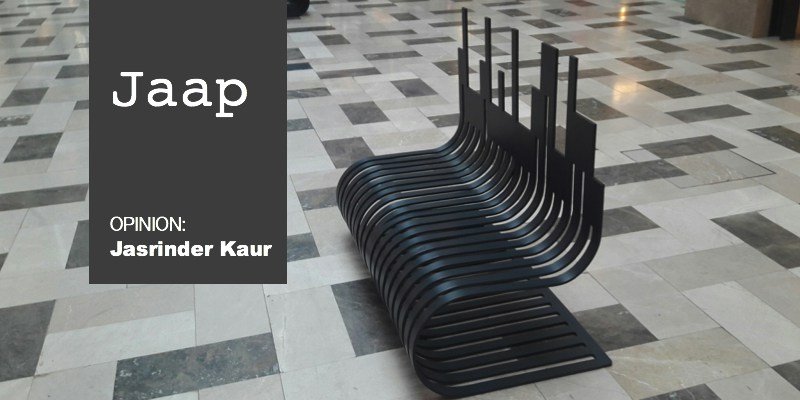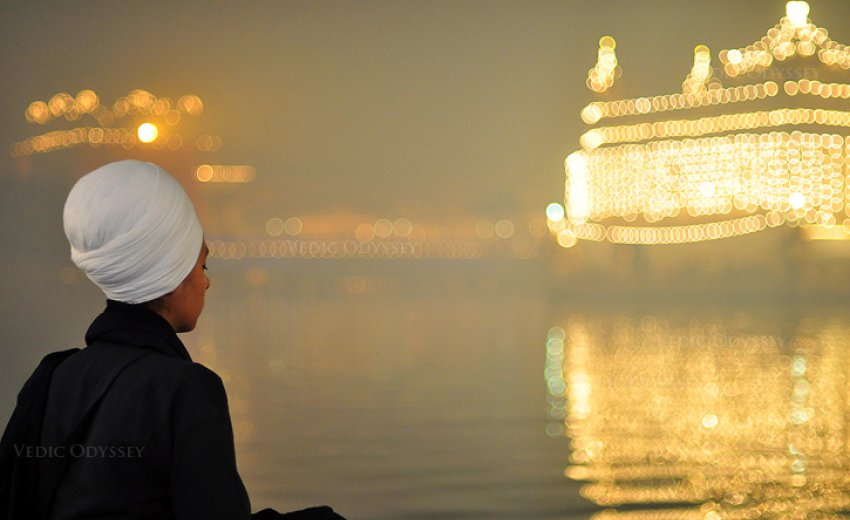 |
| Sitting at ease with Guru Sahib’s idea of Jaap. – PHOTO / ASIA SAMACHAR |
January 16, 2016: Jaap appears frequently in Sikh discourse. Is it chanting, to repeat something continuously? Not to me. It’s so much deeper than merely an act of chanting. Rather, it means to ponder or contemplate.
Being enlightened and aware is to be awake. When you are awake, fully awake, you are in a state of mind where you are fresh, open, alive, connected to all and filled with the glow of love. You hear everything, see everything. You feel deep within your being that all is one with you, that you are not alone.
If we look at our worldly practices today, what is it that brings us to this state of awareness, openness, connectedness, oneness and aliveness.
Is it merely sitting and chanting ‘vaheguru’? Really?
Let’s try an experiment. Let’s sit and chant ‘vaheguru’. What do you notice? Let’s evaluate.
Within a minute, we start to yawn. The yawns get bigger, deeper and increase in frequency with time. The yawns grow so big and deep that they feel like an eternity of yawns coming out. Probably a reminder of how deep in sleep we are. Feel the body, notice its level of exhaustion. Its not just exhausted from the day’s activities, its exhausted from within. Such deep exhaustion, I never knew, like many lifetimes of exhaustion. Is this really what a deepening awareness is all about? In such lethargy, how could one be aware? Only physical sleep come in abundance.
Further, the mind is merely waiting for an opportunity to be distracted. At the tiniest of sound or movement, the eyes fly open. If we choose to keep our eyes shut, then our mind takes this opportunity to analyse where this particular sound could have come from. All sort of scenarios pop up, into an ever-growing interesting drama, until we remind the mind to stop and focus on ‘vaheguru’. And we start all over again. The more we indulge in it, the deeper we are in this state of sleepiness. Is this really the purpose of jaap and simran?
Let’s try a different experiment. Try pondering or contemplating on ‘vaheguru’. Try asking yourself, ‘what is ‘vaheguru’?’. You begin to feel yourself opening up. You notice your breath, and move into a state of gratitude. You begin to hear the sounds around and realise ‘vaheguru’. You see through you mind’s eye and see yourself contemplating and you realise and feel the oneness of all that which is in you, around you and that which you are in. As your mind’s eye broadens the diameter, you see, feel and realise more. Your awareness grows. You feel the Self within you jump of joy as you realise that the Self within and the Self without are connected.
Now, analyse the two scenarios. Look at the energy level. In the first practice, the light is dim and energy dull. In the second practice, one is awake, full of life force, expanding, all-encompassing, and completely in union with oneself and the surrounding.
So, what is jaap, really? A practice to enable the union with God, lightly put? To me, it is the practice of contemplation on the virtues of God. The more you reflect on it, doors to deeper meanings of a particular virtue open-up, usually, directly related to daily experiences. There is no such thing as accidents or coincidences, it is merely our learning journey of the day, our reflections, responses, reactions, all created through choices. Well, my friends, it is in the here and now that this happens. The realisation and the opening of the awareness of now.
If our entire being, the entire mother-earth and all of nature are teachers, and experience is the path to realisation, then, allow our energy level to dictate how close or far we are from our goal. The energy we carry, the frequency we vibrate at, constantly changes with each emotion we experience. How we choose to react or respond, further affects our energy level. This is a continuous process. To remain in the spirit of chardikala is to remain vibrating at a very high frequency. Completely achievable through the constant choices we make. Our choices are totally affected by the level of awareness we carry at that point of time. The level of awareness is affected by the depth of our thoughts, and finally, the depth of our thoughts is affected by our efforts and depth of contemplation on the virtues of God, which is a choice we make to ponder in the first place, when we do jaap.
Let’s talk about the emotion of anger. At the point of time when the emotion of anger erupts, we stand at the ‘Y-junction’ where we are presented with choices. We can either respond with compassion or react with anger. Responding with compassion requires us to understand and accept the actions of the other. To look at the situation through the eyes of the other, project love and compassion to the other, raises our acceptance level of the other. This puts us in a state of chardikala. Reacting with anger, on the other hand, puts us in the ‘meanest of the mean’ category. Is this an exalted energy level?
The one who is justifying his actions feels disconnected and alone, vengeful and will continue fighting to prove that he is right. How is this chardikala. The one who uses love and compassion makes a connection with the source of anger, enables healing, to heal his own wounds and of those around him, all while being enveloped in the grace of God. He takes the step to move on through forgiveness, is he in chardikala? Evaluate the energy level.
It is interesting to note, as in maths, we can test the accuracy of answers given, so in life, we can test our level of connectedness, by merely being aware of our internal state of being and having the wisdom to choose the right actions. This wisdom does not come easy. It’s accumulated though our journey of life experiences and our efforts on reflection of virtues that encapsulates these experiences. Understanding our energy level at each point helps us create an awareness that allows us to respond accordingly. Our responses are always based on our individual vibratory frequency at that point of time.
So, does this mean we don’t chant ‘vaheguru’? No. It means, we means we realise and see vaheguru in all at all times. Its an internal jaap, an external song, a constant vibration, a dance of life, a celebration of the source. A jaap that sees friend and foe alike. A jaap of no judgement but of acceptance. A jaap that fulfils the need to see joy in the eyes of another. A jaap of giving and acceptance. A jaap of constant expansion and all-encompassing and finally a jaap that leads you in threading the thin line to oneness, to God, a most difficult journey; a journey of internalising jaap to self-realisation.
A journey that holds strongly onto positive values, channels the growing energy of compassion to deepen our level of acceptance, creates realisation of oneness and love. And finally, a journey that makes us aware that all this is done through the power of choice.
A journey of trust and faith, of one that releases fear. A journey where looking into your eyes, I see nothing but God, His love and His greatness beyond comprehension. A journey of growth in heart and mind. One that leads to the blossoming of the soul.
Jaap, is an internal journey, the song of life.
Jasrinder Kaur is one of the volunteer editors at Asia Samachar.
- This is the personal opinion of the writer or publication and does not necessarily represent the views of the Asia Samachar.
